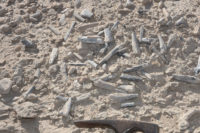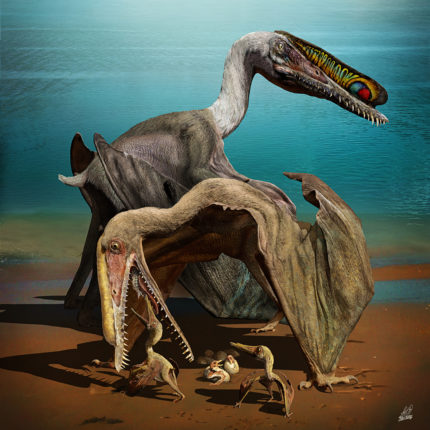 Archaeologists have unearthed hundreds of fossilized pterosaur eggs in northwestern China. The number is unprecedented — 215 eggs — but even more significant from a paleontological perspective is the discovery of 16 unsquashed, still perfectly 3D embryos among them. Before this, only six other well-preserved pterosaur eggs had been found and none of them had 3D embryos inside. Frozen in time at various stages of development, the embryos have to potential to reveal a great deal we don’t know about the creatures, their lives and behaviors. The team saw what a treasure they had when they CT-scanned the eggs.
Archaeologists have unearthed hundreds of fossilized pterosaur eggs in northwestern China. The number is unprecedented — 215 eggs — but even more significant from a paleontological perspective is the discovery of 16 unsquashed, still perfectly 3D embryos among them. Before this, only six other well-preserved pterosaur eggs had been found and none of them had 3D embryos inside. Frozen in time at various stages of development, the embryos have to potential to reveal a great deal we don’t know about the creatures, their lives and behaviors. The team saw what a treasure they had when they CT-scanned the eggs.
The discovery has kicked off debate about whether the creatures could fly as soon as they hatched. Some previous theories had posited that they could, but the paper suggests otherwise. The research team found that the animal’s hind leg bones were more developed than the wings at the time of hatching, and none of the embryos were found with teeth.
“Thus, newborns were likely to move around but were not able to fly, leading to the hypothesis that Hamipterus might have been less precocious than advocated for flying reptiles in general … and probably needed some parental care,” the paper reads.
A separate commentary in Science calls the study “remarkable” but cautions against drawing firm conclusions about how the animal moved immediately after hatching. That’s because it’s hard to pinpoint just how close to hatching the embryos actually were.
The discoveries weren’t made all at once. They are the result of a decade of excavations between 2006 and 2016 at a site in the Turpan-Hami Basin of the Xinjiang Uygur Autonomous Region. Fossils of bones from hundreds of adult male and female pterosaurs (Hamipterus tianshanensis) and babies and young pterosaurs were found in the same location at the collection of eggs all 215 of which were excavated from a single sandstone block.
Pterosaur were toothed flying reptiles who lived on land near bodies of water and fed largely on fish. Their long beaks were filled with pointy teeth and they had a properly intimidating 13-foot wingspan. When they occupied the Turpan-Hami Basin site 120 million years ago in the Lower Cretaceous, there was a large lake which no longer exists. Because of the spectacular finds, scientists refer to the area as “Pterosaur Eden” although it definitely wasn’t one girl-one guy and the eggs appear to have been banished from terrestrial paradise by flash floods.
The sheer number of eggs found together, the researchers say, suggest they belonged to clutches from multiple female pterosaurs and indicate that the animals may have bred in colonies.
It’s worth noting that the massive discovery does not appear to include a nest. Jiang says the eggs had been moved from the place they were originally laid and may have been carried by water after a series of storms hit the animals’ nesting ground.
The findings have been published in the latest issue of the journal Science (requires subscription or payment to read).
